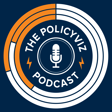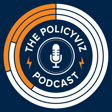
Charting New Horizons: Amanda Makulec on Leadership, Community, and the Human Touch Behind DataViz
Amanda Makulec is the current Executive Director of the Data Visualization Society (DVS), and in this week’s episode of the PolicyViz Podcast, we discuss her journey and the DVS’s evolution as it approaches its fifth anniversary. Amanda shares her experience starting as a volunteer all the way to leading the entire organization. With her second term coming to an end, she emphasizes the importance of term limits and her commitment to ensuring the organization’s sustainability by focusing on operational systems, finances, compliance, and community responsiveness.
Keywords: charting new horizons: amanda makulec on leadership, amanda makulec on leadership, data visualization, Community, trakin tech, Human Touch Behind DataViz, tableau, new horizons: amanda makulec, makulec on leadership, leadership community and the human touch, Touch Behind DataViz, business intelligence, data analyst, amanda makulec on leadership community, Amanda Makulec, amanda makulec, data visualization society, public health, women in analytics, women in data, steve Wexler , mathematics, Al, machine learning
Subscribe to PolicyViz Podcast wherever you get your podcasts.
Become a patron of the PolicyViz Podcast for as little as a buck a month
Find Amanda and her work on the Data Visualization Society website
Follow me on Instagram, LinkedIn, Substack, Twitter, Website, YouTube
Email: jon@policyviz.com
Sponsor: Ant Design System for Figma
Design and develop Ant Design projects faster than ever! The powerful UI kit for Figma based on the most popular React UI library - Ant Design. Create and implement well-documented Ant Design apps in no time!
- Variables, Auto Layout, Variants, Component Properties
- Dedicated Figma Plugin to copy style settings from Figma to code
- Hover and click interactions for easy prototyping
- Switch between light and dark theme
- Developer-friendly components

